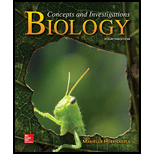
Biology: Concepts and Investigations
4th Edition
ISBN: 9780078024207
Author: Mariëlle Hoefnagels Dr.
Publisher: McGraw-Hill Education
expand_more
expand_more
format_list_bulleted
Concept explainers
Question
Chapter 5, Problem 7MCQ
Summary Introduction
Introduction:
Photorespiration is also referred as oxidative photosynthetic carbon cycle. It is a
Expert Solution & Answer
Want to see the full answer?
Check out a sample textbook solution
Students have asked these similar questions
Based on your results from the Mannitol Salt Agar (MSA) media, which of your bacteria were mannitol fermenters and which were not mannitol fermenters?
help tutor please
Q8. A researcher wants to study the effectiveness of a pill intended to reduce stomach heartburn in pregnant
women. The researcher chooses randomly 400 women to participate in this experiment for 9 months of their
pregnancy period. They all need to have the same diet. The researcher designs two groups of 200 participants:
One group take the real medication intended to reduce heartburn, while the other group take placebo
medication. In this study what are:
Independent variable:
Dependent variable:
Control variable:
Experimental group: "
Control group:
If the participants do not know who is consuming the real pills and who is consuming the sugar pills.
This study is
It happens that 40% of the participants do not find the treatment helpful and drop out after 6 months.
The researcher throws out the data from subjects that drop out. What type of bias is there in this study?
If the company who makes the medication funds this research, what type of bias might exist in this
research work?
Chapter 5 Solutions
Biology: Concepts and Investigations
Ch. 5.1 - What is photosynthesis? Describe the reactants and...Ch. 5.1 - Prob. 2MCCh. 5.1 - Prob. 3MCCh. 5.1 - Prob. 4MCCh. 5.1 - How did the origin of photosynthesis alter Earths...Ch. 5.2 - Prob. 1MCCh. 5.2 - Prob. 2MCCh. 5.2 - Prob. 3MCCh. 5.2 - How does the reaction center chlorophyll interact...Ch. 5.3 - Prob. 1MC
Ch. 5.3 - Prob. 2MCCh. 5.4 - Prob. 1MCCh. 5.4 - Prob. 2MCCh. 5.4 - Prob. 3MCCh. 5.4 - Prob. 4MCCh. 5.5 - What is the relationship between the light...Ch. 5.5 - Prob. 2MCCh. 5.6 - Why is the Calvin cycle also called the C3...Ch. 5.6 - Prob. 2MCCh. 5.6 - What conditions maximize photorespiration?Ch. 5.6 - Prob. 4MCCh. 5.6 - How is the CAM pathway similar to C4 metabolism,...Ch. 5.7 - Prob. 1MCCh. 5.7 - Prob. 2MCCh. 5 - Where does the energy come from to drive...Ch. 5 - Prob. 2MCQCh. 5 - Prob. 3MCQCh. 5 - The evolution of photosynthesis resulted in a. an...Ch. 5 - Prob. 5MCQCh. 5 - Prob. 6MCQCh. 5 - Prob. 7MCQCh. 5 - A plant that opens its stomata only at night is a...Ch. 5 - Imagine that multiple simultaneous volcanic...Ch. 5 - Prob. 2WIOCh. 5 - Prob. 3WIOCh. 5 - Would a plant grow belier in a room painted blue...Ch. 5 - Determine whether each of the following molecules...Ch. 5 - Of the many groups of photosynthetic bacteria,...Ch. 5 - Prob. 7WIOCh. 5 - Over the past decades, the CO2 concentration in...Ch. 5 - How does photosynthesis help compensate for...Ch. 5 - How is the CAM pathway adaptive in a desert...Ch. 5 - Explain how C4 photosynthesis is based on a...Ch. 5 - Explain why each of the following misconceptions...Ch. 5 - Prob. 1PITCh. 5 - 2. How would you incorporate the Calvin cycle,...Ch. 5 - Prob. 3PITCh. 5 - Prob. 4PITCh. 5 - Prob. 5PIT
Knowledge Booster
Learn more about
Need a deep-dive on the concept behind this application? Look no further. Learn more about this topic, biology and related others by exploring similar questions and additional content below.Similar questions
- What is behavioral adaptarrow_forward22. Which of the following mutant proteins is expected to have a dominant negative effect when over- expressed in normal cells? a. mutant PI3-kinase that lacks the SH2 domain but retains the kinase function b. mutant Grb2 protein that cannot bind to RTK c. mutant RTK that lacks the extracellular domain d. mutant PDK that has the PH domain but lost the kinase function e. all of the abovearrow_forwardWhat is the label ?arrow_forward
- Can you described the image? Can you explain the question as well their answer and how to get to an answer to an problem like this?arrow_forwardglg 112 mid unit assignment Identifying melting processesarrow_forwardGive only the mode of inheritance consistent with all three pedigrees and only two reasons that support this, nothing more, (it shouldn't take too long)arrow_forward
- Oarrow_forwardDescribe the principle of homeostasis.arrow_forwardExplain how the hormones of the glands listed below travel around the body to target organs and tissues : Pituitary gland Hypothalamus Thyroid Parathyroid Adrenal Pineal Pancreas(islets of langerhans) Gonads (testes and ovaries) Placentaarrow_forward
arrow_back_ios
SEE MORE QUESTIONS
arrow_forward_ios
Recommended textbooks for you
 Biology (MindTap Course List)BiologyISBN:9781337392938Author:Eldra Solomon, Charles Martin, Diana W. Martin, Linda R. BergPublisher:Cengage Learning
Biology (MindTap Course List)BiologyISBN:9781337392938Author:Eldra Solomon, Charles Martin, Diana W. Martin, Linda R. BergPublisher:Cengage Learning
 Biology: The Dynamic Science (MindTap Course List)BiologyISBN:9781305389892Author:Peter J. Russell, Paul E. Hertz, Beverly McMillanPublisher:Cengage Learning
Biology: The Dynamic Science (MindTap Course List)BiologyISBN:9781305389892Author:Peter J. Russell, Paul E. Hertz, Beverly McMillanPublisher:Cengage Learning- Basic Clinical Lab Competencies for Respiratory C...NursingISBN:9781285244662Author:WhitePublisher:Cengage
 Biology Today and Tomorrow without Physiology (Mi...BiologyISBN:9781305117396Author:Cecie Starr, Christine Evers, Lisa StarrPublisher:Cengage Learning
Biology Today and Tomorrow without Physiology (Mi...BiologyISBN:9781305117396Author:Cecie Starr, Christine Evers, Lisa StarrPublisher:Cengage Learning

Biology (MindTap Course List)
Biology
ISBN:9781337392938
Author:Eldra Solomon, Charles Martin, Diana W. Martin, Linda R. Berg
Publisher:Cengage Learning


Biology: The Dynamic Science (MindTap Course List)
Biology
ISBN:9781305389892
Author:Peter J. Russell, Paul E. Hertz, Beverly McMillan
Publisher:Cengage Learning

Basic Clinical Lab Competencies for Respiratory C...
Nursing
ISBN:9781285244662
Author:White
Publisher:Cengage


Biology Today and Tomorrow without Physiology (Mi...
Biology
ISBN:9781305117396
Author:Cecie Starr, Christine Evers, Lisa Starr
Publisher:Cengage Learning
Photosynthesis & Respiration | Reactions | Chemistry | FuseSchool; Author: FuseSchool - Global Education;https://www.youtube.com/watch?v=3XIyweZg6Sw;License: Standard YouTube License, CC-BY